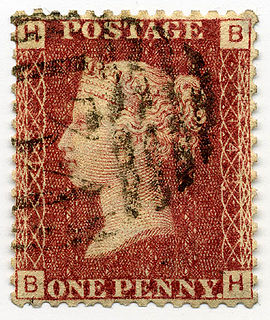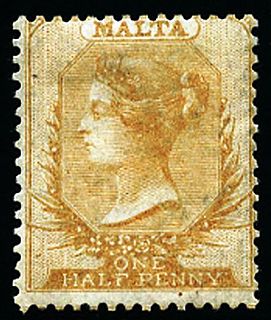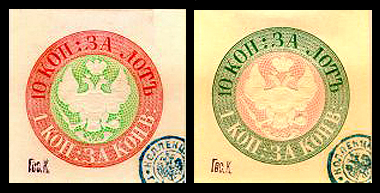
Philately is the study of postage stamps and postal history. It also refers to the collection, appreciation and research activities on stamps and other philatelic products. Philately involves more than just stamp collecting or the study of postage; it is possible to be a philatelist without owning any stamps. For instance, the stamps being studied may be very rare or reside only in museums.

This a survey of the postage stamps and postal history of the Russian Empire, the Soviet Union and the modern Russian Federation.

The postage stamps of Ireland are issued by the postal operator of the independent Irish state. Ireland was part of the United Kingdom of Great Britain and Ireland when the world's first postage stamps were issued in 1840. These stamps, and all subsequent British issues, were used in Ireland until the new Irish Government assumed power in 1922. Beginning on 17 February 1922, existing British stamps were overprinted with Irish text to provide some definitives until separate Irish issues became available. Following the overprints, a regular series of definitive stamps was produced by the new Department of Posts and Telegraphs, using domestic designs. These definitives were issued on 6 December 1922; the first was a 2d stamp, depicting a map of Ireland. Since then new images, and additional values as needed, have produced nine definitive series of different designs.

The Inverted Head Four Annas of India is a postage stamp prized by collectors. The 1854 first issues of India included a Four Annas value in red and blue. It was one of the world's first multicolored stamps; the Basel Dove preceded it by nine years. However, an invert error occurred during production, showing the head "upside down."

The postal history of Malta began in the early modern period, when pre-adhesive mail was delivered to foreign destinations by privately owned ships for a fee. The earliest known letter from Malta, sent during the rule of the Order of St John, is dated 1532. The first formal postal service on the islands was established by the Order in 1708, with the post office being located at the Casa del Commun Tesoro in Valletta. The first postal markings on mail appeared later on in the 18th century.

This is a survey of the postage stamps and postal history of Estonia. The stamps of Estonia are issued by the postal administration Eesti Post which is the country's only provider of universal postal services.

The postal history of Turkey and its predecessor state, the Ottoman Empire, dates to the 18th century when foreign countries maintained courier services through their consular offices in the Empire. Although delayed in the development of its own postal service, in 1863 the Ottoman Empire became the second independent country in Asia to issue adhesive postage stamps, and in 1875, it became a founding member of the General Postal Union, soon to become the Universal Postal Union. The Ottoman Empire became the Republic of Turkey in 1923, and in the following years, its postal service became more modernized and efficient and its postage stamps expertly designed and manufactured.
Soviet Union stamp catalogue is a national catalogue of the RSFSR and USSR postage stamps and miniature sheets, which was being published in the USSR by the “Soyuzpechat” Central Philatelic Agency (CPA) and some other publishers related to the Ministry of Communications. The catalogue usually republished in corpore around once in a 10–15 years. In between republications, additional issues came out every year. These issues contains descriptions of stamps and miniature sheets issued in USSR last year.

Plating refers to the reconstruction of a pane or "sheet" of postage stamps printed from a single plate by using individual stamps and overlapping strips and blocks of stamps. Likewise, if a sheet 10 or 20 postal cards is typeset, the variations of the letters or design elements may allow reconstruction or plating of the sheets based on these differences.
Between 1851 and 1860, the Grand Duchy of Tuscany, an independent Italian state until 1859 when it joined the United Provinces of Central Italy, produced two postage stamp issues which are among the most prized classic stamp issues of the world, and include the most valuable Italian stamp.

A specimen stamp is a postage stamp or postal stationery indicium sent to postmasters and postal administrations so that they are able to identify valid stamps and to avoid forgeries. The usual method of invalidating the stamps is either overprinting in ink or perforating the word Specimen across the stamp and where English is not the common language, the words Muestra (Spanish), Monster (Dutch), Muster (German) or Образец have been used instead.

Postage stamp paper is the foundation or substrate of the postage stamp to which the ink for the stamp's design is applied to one side and the adhesive is applied to the other. The paper is not only the foundation of the stamp but it has also been incorporated into the stamp's design, has provided security against fraud and has aided in the automation of the postal delivery system.

Edward Loines Pemberton was a pioneering philatelist and stamp dealer who was a leading advocate of the scientific school of philately and a founding member of The Philatelic Society, London, now The Royal Philatelic Society London. Pemberton was entered on the Roll of Distinguished Philatelists in 1921 as one of the fathers of philately. He was born in New York City but educated in Britain by relatives when his parents died shortly after his birth. His son, Percival Loines Pemberton (1875-1949) was also an eminent philatelist.

The Halfpenny Yellow is the first postage stamp issued by the Crown Colony of Malta. Depicting Queen Victoria, it was only valid for local postage and it was originally issued on 1 December 1860. It was the only stamp issued by Malta for two and a half decades, and during this period various reprints were made with differences in colour shade, perforation and watermark. When control of Malta's postal service was transferred to the islands' colonial government on 1 January 1885, the stamp was withdrawn and it was replaced by a set of definitive stamps.

Filateliya (Philately) or formerly Filateliya SSSR is a Russian central philatelic magazine. It first appeared in 1966 as the monthly bulletin Filateliya SSSR and was issued by the USSR Ministry of Communications. The magazine content includes the history and design of postage stamps, and other related themes.

The Gold Standard issue or Small Head issue was the first definitive series of postage stamps issued by the Soviet Union between 1923 and 1927. The stamps were designed by Ivan Shadr.

Stamps of the Soviet Union were issued in the period 1923 to 1991. They were labeled with the inscription Russian: "Почта СССР". In the thematics, Soviet stamps reflected to a large extent the history, politics, economics and culture of this world's first socialist state.

International trading tax stamp is kind of revenue stamps that were used in the Soviet Union in the 1920s and 1930s for taxation of the trade in stamps. The latter were considered a commodity for which philatelists could be taxed. This type of taxation was introduced by the Soviet government in addition to revenue it collected from stamp sales. International trading tax stamps were issued by the Posledgol Central Commission of VTsIK, the Organisation of the Commissioner for Philately and Scripophily and, later, by the Soviet Philatelic Association.

Definitive stamps of Russia are the regular postage stamp issues produced in the Russian Empire and RSFSR between 1857 and 1923, and in the Russian Federation since 1992.


























